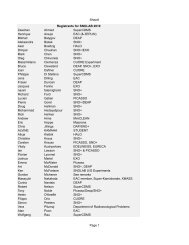Levels of heavy metals in candy packages and candies ... - snolab
Levels of heavy metals in candy packages and candies ... - snolab
Levels of heavy metals in candy packages and candies ... - snolab
You also want an ePaper? Increase the reach of your titles
YUMPU automatically turns print PDFs into web optimized ePapers that Google loves.
416 K.-C. Kim et al. / Food Research International 41 (2008) 411–418<br />
Table 4<br />
<strong>Levels</strong> <strong>of</strong> <strong>heavy</strong> <strong>metals</strong> <strong>in</strong> c<strong>and</strong>ies likely to be consumed by small children<br />
Concentration <strong>of</strong> <strong>heavy</strong> <strong>metals</strong> (mg kg 1 )<br />
Cu Cd Pb Mn Cr Co Zn<br />
Manufactur<strong>in</strong>g<br />
country (sample no.)<br />
South Korea (31) 0.1–3.2 (0.53) a ND b ND–0.1 (0.02) ND–6.0 (0.55) ND–0.1 (0.02) ND–0.05 (0.005) 0.01–8.3 (1.18)<br />
Ch<strong>in</strong>a (39) ND–10.0 (0.78) ND–0.05 (0.001) ND–1.3 (0.12) ND–11.2 (2.61) ND–25.1 (1.14) ND–0.04 (0.003) 0.1–20.8 (2.8)<br />
Mexico (3) 0.03–0.2 (0.1) ND ND ND ND–0.03 (0.008) ND–0.4 (0.13) ND–0.23 (0.14)<br />
Malaysia (3) 0.1–3.5 (0.37) ND 0.02–0.16 (0.08) ND–6.6 (2.21) 0.1–0.6 (0.26) ND–0.02 (0.008) 0.1–7.9 (2.74)<br />
Indonesia (3) ND–2.2 (0.83) ND–0.01 (0.003) 0.02–0.06 (0.04) 0.8–5.1 (2.26) ND –0.3 (0.12) ND–0.04 (0.02) 0.1–13.2 (5.36)<br />
USA (2) 0.31, 0.38 ND ND, 0.01 ND, 0.11 ND ND 0.09, 0.94<br />
Colombia (2) 0.86, 0.17 ND 0.07, ND 0.29, 0.02 0.005, ND ND 0.37, ND<br />
Others (9) 0.08–2.7 (1.28) ND ND–0.3 (0.06) ND–7.3 (2.03) ND–0.4 (0.14) ND–0.07 (0.02) 0.1–11.3 (3.37)<br />
(): average concentrations <strong>of</strong> <strong>heavy</strong> <strong>metals</strong>.<br />
b ND: not detected.<br />
a<br />
The directive factor <strong>of</strong> lead contam<strong>in</strong>ation had orig<strong>in</strong>ated<br />
<strong>in</strong> the lead-based color <strong>in</strong>k <strong>of</strong> the outer cover. In particular,<br />
Pb was detected at high concentrations <strong>in</strong> cases <strong>of</strong><br />
green- or yellow-coloured <strong>packages</strong>; pigments such as lead<br />
chromate, lead sulphate, <strong>and</strong> lead oxide could confer these<br />
colours.<br />
The concentration <strong>of</strong> chromium was also higher <strong>in</strong> cases<br />
when the lead concentration was high, as illustrated <strong>in</strong><br />
Fig. 2. These results demonstrate that harmful pigments<br />
such as lead chromate, which have been prohibited by<br />
law from be<strong>in</strong>g used <strong>in</strong> packag<strong>in</strong>g materials, are be<strong>in</strong>g<br />
<strong>in</strong>tentionally used <strong>in</strong> some countries.<br />
Table 4 illustrates the levels <strong>of</strong> <strong>heavy</strong> <strong>metals</strong> <strong>in</strong> c<strong>and</strong>ies<br />
that are likely to be consumed by small children.<br />
We obta<strong>in</strong>ed 92 samples from retail stores near elementary<br />
schools <strong>in</strong> South Korea. Like <strong>c<strong>and</strong>y</strong> package, sample<br />
blank was analyzed with each sample batch. In<br />
general, z<strong>in</strong>c, manganese, <strong>and</strong> copper were detected at<br />
high concentrations at averages <strong>of</strong> 2.14, 1.58, <strong>and</strong><br />
0.70 mg kg 1 , respectively, as compared to the concentrations<br />
<strong>of</strong> other <strong>metals</strong> <strong>in</strong> the 92 samples. The types<br />
<strong>of</strong> c<strong>and</strong>ies sampled were lollipops, chocolate, chew<strong>in</strong>g<br />
gum, jelly, etc. On the whole, the migration <strong>of</strong> <strong>heavy</strong><br />
<strong>metals</strong> from the <strong>c<strong>and</strong>y</strong> package to the <strong>c<strong>and</strong>y</strong> was not<br />
observed <strong>in</strong> this result.<br />
However, a part <strong>of</strong> the samples appeared to be contam<strong>in</strong>ated<br />
due to their <strong>packages</strong>, as described <strong>in</strong> Table 5. These<br />
results illustrate that some <strong>heavy</strong> <strong>metals</strong> could migrate<br />
from the package when the <strong>c<strong>and</strong>y</strong> surfaces are sticky,<br />
allow<strong>in</strong>g the surface <strong>of</strong> the <strong>c<strong>and</strong>y</strong> to adhere to the <strong>in</strong>ner<br />
cover <strong>of</strong> the package. Further, this would allow lead-based<br />
<strong>in</strong>ks <strong>in</strong> the outer package layer to migrate <strong>in</strong>to the <strong>c<strong>and</strong>y</strong><br />
because the <strong>packages</strong>, as mentioned <strong>in</strong> Table 5, were so<br />
poorly designed that their <strong>in</strong>ner coat<strong>in</strong>gs did not ma<strong>in</strong>ta<strong>in</strong><br />
their structural <strong>in</strong>tegrity.<br />
3.3. Analysis <strong>of</strong> hexavalent chromium [Cr(VI)] <strong>in</strong> <strong>c<strong>and</strong>y</strong><br />
<strong>packages</strong><br />
Table 6 presents the concentrations <strong>of</strong> Cr(VI) <strong>and</strong> Pb <strong>in</strong><br />
<strong>c<strong>and</strong>y</strong> <strong>packages</strong> that were detected at levels over<br />
100 mg kg 1 <strong>of</strong> the total Cr. The colors <strong>of</strong> these <strong>c<strong>and</strong>y</strong><br />
<strong>packages</strong> were ma<strong>in</strong>ly yellow or green. In this table, numbers<br />
1 <strong>and</strong> 2 were box-type <strong>c<strong>and</strong>y</strong> <strong>packages</strong>, which were<br />
made <strong>of</strong> polyethylene hard plastic, <strong>and</strong> the Cr(VI) were<br />
detected less than 15% <strong>of</strong> the total Cr. This result does<br />
not <strong>in</strong>dicate that the <strong>packages</strong> were not made us<strong>in</strong>g Cr(VI),<br />
but it means that extraction <strong>of</strong> the Cr compounds by toluene<br />
was difficult <strong>in</strong> hard plastic materials. On the other<br />
h<strong>and</strong>, sample numbers from 3 to 7 were wrapper-type<br />
<strong>c<strong>and</strong>y</strong> <strong>packages</strong>, which were coated with polypropylene<br />
<strong>and</strong> had pr<strong>in</strong>ted outer covers, <strong>and</strong> Cr(VI) was detected <strong>in</strong><br />
these <strong>packages</strong> at 87–105.0% <strong>of</strong> the total Cr, <strong>and</strong> the <strong>in</strong>k<br />
components could be perfectly extracted from the pr<strong>in</strong>ted<br />
outer covers us<strong>in</strong>g the toluene solvent. These results imply<br />
that the Cr(VI) <strong>in</strong> the package orig<strong>in</strong>ates from <strong>in</strong>k pigments<br />
such as PbCrO 4 <strong>and</strong> CrO 3 .








